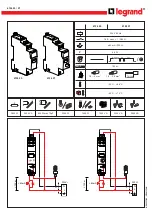
Before commencing the installation
• Disconnect the power supply of the device.
• Ensure that devices cannot be accidentally retriggered.
• Verify isolation from the supply.
• Ground and short-circuit.
• Cover or enclose neighbouring units that are live.
• Follow the engineering instructions (IL) of the device
concerned.
• Only suitably qualified personnel in accordance with
EN 50110-1/-2 (VDE 0105 Part 100) may work on this device/
system.
• Before installation and before touching the device ensure
that you are free of electrostatic charge.
• The functional earth (FE) must be connected to the
protective earth (PE) or to the potential equalizing.
The system installer is responsible for implementing this
connection.
• Connecting cables and signal lines should be installed so
that inductive or capacitive interference do not impair the
automation functions.
• Install automation devices and related operating elements
in such a way that they are well protected against uninten-
tional operation.
• Suitable safety hardware and software measures should
be implemented for the I/O connection so that a cable or
wire breakage on the signal side does not result in
undefined states in the automation device.
• Ensure a reliable electrical isolation of the low voltage for
the 24 V supply. Only use power supply units complying
with IEC 60364-4-41 or HD 384.4.41 S2 (VDE 0100 part 410).
• Deviations of the mains voltage from the nominal value
must not exceed the tolerance limits given in the technical
data, otherwise this may cause malfunction and
dangerous operation.
• Emergency-Stop devices complying with IEC/EN 60204-1
must be effective in all operating modes of the automation
devices. Unlatching the emergency switching off devices
must not cause restart.
• Built-in devices for enclosures or cabinets must only be
run and operated in an installed state, desk-top devices or
portable devices only when the housing is closed.
• Measures should be taken to ensure the proper restart of
programs interrupted after a voltage dip or failure. This
should not cause dangerous operating states even for a
short time. If necessary, emergency switching off devices
should be implemented.
• Wherever faults in the automation system may cause
damage to persons or property, external measures must
be implemented to ensure a safe operating state in the
event of a fault or malfunction (for example, by means of
separate limit switches, mechanical interlocks, etc.).
• During operation, and depending on their degree of
protection, variable frequency drives may have live,
uninsulated, moving, and/or rotating parts, as well as hot
surfaces.
• The impermissible removal of the required cover,
improper installation or incorrect operation of the motor or
variable frequency drive can cause the failure of the
device and serious injury and/or material damage.
• Comply with all applicable national accident prevention
regulations (e.g. BGV A3) when working with energized
variable frequency drives.
• The electrical installation must be carried out in
accordance with the relevant regulations (e.g. with regard
to cable cross sections, fuses, PE).
• All transport, installation, commissioning and mainte-
nance work must only be carried out by trained personnel
(observe IEC 60364, HD 384 or DIN VDE 0100 and national
accident prevention regulations).
• If applicable, systems in which variable frequency drives
are installed must be equipped with additional monitoring
and protective devices in accordance with the applicable
safety regulations, e.g., the German Equipment and
Product Safety Act, accident prevention regulations, etc.
Making changes to the variable frequency drives by using
the operating software is allowed.
• Keep all covers and doors closed during operation.
• When designing the machine, the user must incorporate
mechanisms and measures that limit the consequences of
a drive controller malfunction or failure (an increase in
motor speed or the motor?9s sudden stop) so as to prevent
hazards to people and property, e.g.:
– Additional stand-alone devices for monitoring parame-
ters that are relevant to safety (speed, travel, end
positions, etc.)
– Electrical and non-electrical safety devices (interlocks
or mechanical locks) for mechanisms that protect the
entire system
– Due to the possibility of there being capacitors that are
still holding a charge, do not touch live device parts or
terminals immediately after disconnecting the variable
frequency drives from the supply voltage. Heed the
corresponding labels on the variable frequency drives
Eaton Industries
G
mbH
Safety instructions
Danger!
Dangerous electrical voltage!
Summary of Contents for 118701
Page 1: ...Manual ESR5 NO 41 24VAC DC Safety relay 12 19 MN049009EN...
Page 4: ......































